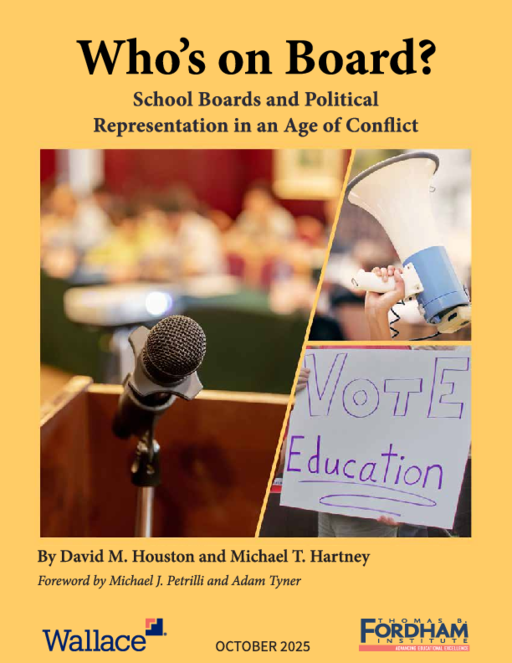Breadcrumb
- Wallace
- Reports
- Who’s On Board? School Boards An...
Who’s on Board?
School Boards and Political Representation in an Age of Conflict

- Author(s)
- David M. Houston and Michael T. Hartney
- Publisher(s)
- Thomas B. Fordham Institute
Summary
How we did this
Researchers conducted an anonymous survey of more than 5,300 local school board members across the United States, asking about their demographic and professional backgrounds, their political leanings, and their views on a number of hot-button topics in K-12 education.
In recent years, national news media have reported on a spate of heated, often partisan confrontations at local school board meetings across the country. These reports appear to suggest that such conflict has become the norm, but in fact, the vast majority of school board meetings are characterized by relatively calm, nonpartisan discussion about district finances, staff hiring, school resources, and the like.
This study finds that school board members’ political and educational views tend to be more or less in sync with those of voters in their districts and with those of the U.S. public as a whole.
This is the most comprehensive study of American school board members to date. The authors collected a wealth of survey data on board members’ racial and ethnic backgrounds, professional experiences, political affiliations, views on controversial topics in educational policy, and more. They also cross-checked this data against existing information about community demographics and voter preferences in specific districts. This allowed them to gauge the extent to which those board members’ views match up with those of the people they serve.
Key Findings include:
- Relatively few school boards have become embroiled in heated debates over DEI policies, bathroom rules for transgender students, and other hot-button issues. As the authors conclude: “School board politics in most communities appears to be less heated and less driven by partisan conflict than is often portrayed in the media.”
- To make sense of school board representation in the U.S., it is important to distinguish between the total number of school board members and the number of students each board member represents. A majority of the nation’s 13,000 school districts are located in rural, sparsely populated areas. But much of the student population is concentrated in larger urban areas. This means that while most school board members represent relatively small districts, most students are represented by a small number of board members from the more populous towns and cities.
- Black and Hispanic people nationwide are underrepresented on school boards. Each group makes up only 4 percent of board members nationally versus 12 percent and 19 percent of the population respectively. But because Black and Hispanic board members tend to represent larger districts, they represent 9 percent of the nation’s students.
- People who identify as politically moderate make up the largest share of board members across the country, at 39 percent (representing 40 percent of all students). Overall, 37 percent of board members identify as conservative and 24 percent as liberal. However, in larger school districts (representing a greater share of students), board members more often identify as liberal than conservative.
- Board members are far more educated than the general public—nearly half hold postgraduate degrees, compared with 14 percent of U.S. adults. Further, board members are far more likely to have worked as educators—a quarter are current or former teachers, compared with just 3 percent of U.S. adults in general.
- While board members tend to be aligned with local voters in their opinions about controversial issues related to race, gender, and K-12 education, they diverge from the broader public in their opinions about local school quality and charter schools: 75 percent of board members would give local schools a grade of B or higher, compared with just half of U.S. adults; and only 29 percent of board members support charter schools, compared with 45 percent of U.S. adults.
- While school board elections have become increasingly competitive in some of the nation’s largest school districts, most local board elections are not very partisan, and teachers’ unions have little influence on those elections.
This study was funded by The Wallace Foundation. In 2010 Wallace sponsored similar school board research in the wake of No Child Left Behind legislation to shed light on school boards and their members and board governance across the country. The National School Boards Association and the Iowa School Boards Foundation also contributed to that study.

School board politics in most communities appears to be less heated and less driven by partisan conflict than is often portrayed in the media.
Key Takeaways
- Contrary to recent news reports, local school board meetings rarely erupt in angry, partisan conflict, and board members’ views tend to align with their constituents on hot-button issues.
- The nation’s school board members are disproportionately white, and most minority board members are concentrated in larger, more racially diverse districts.
- Nearly half of school board members hold graduate degrees, which is typical with profiles of elected officials. A quarter have teaching experience, which may point to a natural self-selection of those invested in schools.
- Most board members nationwide identify as politically moderate or conservative, with less than a quarter identifying as liberals. But when you account for district size and where board members are concentrated, liberal board members represent more than a third of all students, with conservatives down to just a quarter.
What We Don't Know
Survey respondents were all individual board members. The study does not account for (a) the stance a full board might take on any issue nor how it compares with its communities; or (b) the relative role or authority of each individual board member, for example whether someone is a board chair or other officer.

